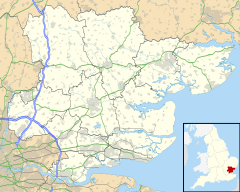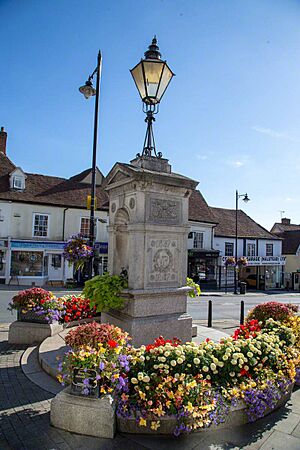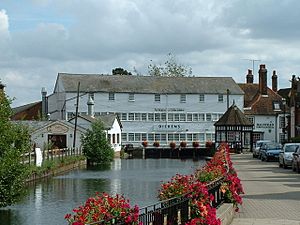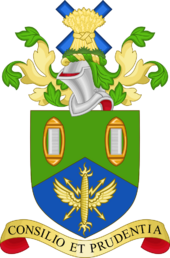Halstead facts for kids
Quick facts for kids Halstead, Essex |
|
|---|---|
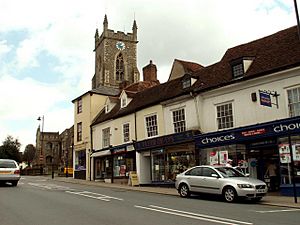 St Andrew's Church and Halstead High Street |
|
| Population | 11,906 (2011) |
| OS grid reference | TL816306 |
| Civil parish |
|
| District |
|
| Shire county | |
| Region | |
| Country | England |
| Sovereign state | United Kingdom |
| Post town | HALSTEAD |
| Postcode district | CO9 |
| Dialling code | 01787 |
| Police | Essex |
| Fire | Essex |
| Ambulance | East of England |
| EU Parliament | East of England |
| UK Parliament |
|
Halstead is a town and civil parish in Essex, England. It is part of the Braintree District. In 2011, about 11,906 people lived there. By 2019, this number grew to about 12,161.
The town is located near Colchester and Sudbury. It sits in the beautiful Colne Valley. Halstead is also twinned with Haubourdin, a town in France.
Contents
History of Halstead
Halstead is a very old community. It first grew on a hill north of the River Colne.
Early Settlements
Archaeologists have found signs that people lived in Halstead a very long time ago. This includes the early Bronze Age. They also found Iron Age and Roman settlements. One Roman villa was near Greenstead Hall. Saxon pottery was found there too. Another Roman villa was found south of the River Colne. This shows that people settled in the fertile river valley early on.
The name Halstead comes from old English words. Gehæld or hald means "refuge," "shelter," or "healthy." Stede means "site," "place," or "farm." So, Halstead means "healthy farm" or "place of refuge."
Domesday Book and Norman Times
In the 11th century, after the Norman Conquest, the name changed a bit. In 1086, Halstead was written as Haltesteda or Halsteda in the Domesday Book. This was a big survey of England ordered by William the Conqueror.
At that time, Halstead was one of the larger settlements. It had four main owners. Most of the land was given by King William to William de Warenne. He became the main lord of the area. Another part of Halstead was owned by Richard_fitz_Gilbert.
In 1088, there was a rebellion. William de Warenne supported William Rufus and became the Earl of Surrey. Richard fitz Gilbert supported another side. His part of Halstead then went to his son, Gilbert fitz Richard.
Growth of the Town
Halstead had a market even before 1251. That year, the king officially allowed a weekly market and a yearly fair. More permissions for the market were given in 1330 and 1467. The market was held in a place called Chipping Hill.
St Andrew's Church was built by 1276. The town then grew around this church and the market. Around 1413, Holy Trinity Chapel was built. This chapel later disappeared. In 1843, a new church, Holy Trinity Church, was built in its place.
Exploring Halstead
Halstead has a wide High Street. The old St Andrew's Church from the 14th century stands out here. It was fixed up a lot in Victorian times. But it still has old decorations and tomb monuments from the 14th century and even earlier.
Town Features
You can take a walk up Market Hill to see the historic part of Halstead. Some buildings on Market Hill are from the 14th century. For example, Whispers wine bar was once a special prayer house. It has a beautiful wooden ceiling with carved angels.
There's also a river walk that goes through the town. Just outside Halstead is Broaks Wood. It's a great place for walks and is owned by the Forestry Commission.
Halstead Public Gardens were started in 1900. They are famous for their lovely flower displays. The town has won awards in the Britain in Bloom competition many times. These displays bring many visitors to Halstead. You can also visit the Antiques Centre inside Townsford Mill. It sells many different items, from clothes to things for your home.
Halstead's Mills
Townsford Mill is a building that goes over the river at the bottom of the town. In 1818, Samuel Courtauld built two mills. One was Townsford Mill in Halstead. The other was in Bocking.
Silk Production
In 1824, Samuel Courtauld sold Halstead Mill to Stephen Beuzeville. In 1825, they agreed to change Halstead Mill to make silk. Beuzeville was an expert in making crêpe. Courtauld would set up the machines and run the mill. The mill started working by the summer of 1825.
New machines were important, but the mills still needed many workers. Most of these workers were young women. In 1838, over 92% of the workers were female. Many Belgian refugees, who came to England to escape religious problems, also worked there.
In 1827, Stephen Beuzeville went bankrupt. Samuel Courtauld then bought Halstead Mill completely in 1828. Stephen and his father later worked for Courtaulds.
When Queen Victoria died in 1902, much of the black crepe for her funeral was made at Townsford Mill. It was made by Samuel Courtauld's company. Some parts of the original Courtauld factory are still standing today. They are special historic buildings.
Evans Electroselenium Ltd
Arthur Evans was an engineer and businessman. During World War II, he started making special light sensors called selenium photocells. He began in a small workshop in Harlow, Essex. These sensors were useful for the military. The government encouraged him to find a bigger place and grow his business.
He chose Halstead and found a site near St Andrew's Church. After the war, his company, Evans Electroselenium Ltd (EEL), grew. They made many scientific instruments that used photocells. These included flame photometers and colorimeters. Later, they added instruments for electrochemistry.
The business was eventually bought by Corning Inc. Today, it is part of Siemens Healthineers. It now operates from a site in Sudbury, Suffolk. The Halstead site was turned into houses called Evans Court. This was to honor Arthur Evans. The Science Museum in London has a collection of EEL instruments. The Halstead Town Museum also has some.
Things to Do in Halstead
Halstead has a library in a large, open building. It was built in 1864–1866 as a place for selling corn. It also used to be a technical school.
Local Attractions
Nearby is Moyns Park. This is a beautiful old Elizabethan country house. It is said that Ian Fleming finished writing his famous novel From Russia, with Love there.
The town's history society has regular meetings. There is also a town museum at the town council offices. It shows old items and things of local interest. The Colne Valley Postal History Museum is a private museum. It has one of the largest collections of old post office letter boxes and telephone kiosks. It is on Head Street and has open days often.
The old Trinity Church, designed by Sir Giles Gilbert Scott, is used for concerts and art shows sometimes. The Empire Theatre in Butler Road hosts bingo nights. Halstead is also home to Hume's Bakery, which opened in 1960.
The Jubilee Drinking Fountain is a stone fountain. It was designed by Leonard Shuffrey. George Courtauld gave it to the town. It celebrates Queen Victoria's 50 years as queen.
Famous People from Halstead
Many interesting people have connections to Halstead:
- Robert Bourchier, 1st Baron Bourchier (died 1349), a top legal official in England, owned land here.
- John Bourchier, 2nd Baron Bourchier (died 1400), a soldier, inherited land here.
- Bartholomew Bourchier, 3rd Baron Bourchier (died 1409), a politician, died at his home here.
- Bernard Barton (1784–1849), a Quaker poet, learned his trade and got married here.
- Dummy, the Witch of Sible Hedingham (c. 1788 – 1863), a deaf woman accused of witchcraft, died in the Halstead workhouse.
- Samuel Courtauld (1793–1881), who started a textile mill here in 1818.
- George Courtauld (1802–1861), another textile leader, was married here in 1829.
- Isaac Baker Brown (1811–1873), a doctor specializing in women's health, went to school here.
- Augustine Stow (1833–1903), an Australian politician, was born here.
- Sir John Mark Davies (1840–1919), another Australian politician, was born here.
- Samuel Courtauld (1876–1947), an art collector, became a director of the silk mill here in 1901.
- Gwen Ffrangcon-Davies (1891–1992), an actress, died here.
- Alan Sainsbury, Baron Sainsbury (1902–1998), whose family founded the Sainsbury's supermarket, lived and died here.
- Steve Lamacq (born 1964), a BBC Radio 6 Music DJ, grew up here and still lives here.
- Matt Cardle (born 1983), who won The X Factor in 2010, lives here.
Schools in Halstead
Halstead has three primary schools: Holy Trinity, St Andrew's, and Richard de Clare. The town's secondary school is The Ramsey Academy. It is located north of the town center.
There are other secondary schools nearby that students can choose from. These include schools in Sible Hedingham, Braintree, or Colchester. The Yellow House School in Sible Hedingham is a private school for students with special needs. For further education, the closest colleges are in Braintree and the University of Essex at its Colchester Campus.
Places to Worship
The main Anglican church in Halstead is St Andrew's on Parsonage Street. Holy Trinity Church, Halstead is no longer used for regular services. It is now looked after by the Churches Conservation Trust.
Halstead also has a Methodist church, which opened in 1874. The Baptist Church is on Hedingham Road. Grace Baptist Church and the Catholic Church of St Francis of Assisi are on Colchester Road. The United Reformed Church of Halstead is on Kings Road.
Media and News
Local news and TV shows for Halstead are provided by BBC East and ITV Anglia. You can get TV signals from the Sudbury TV transmitter.
Radio and Newspapers
Local radio stations include BBC Essex (103.5 FM) and Heart East (96.1 FM). You can also listen to Greatest Hits Radio East (100.2 FM) and Actual Radio, a DAB station. Leisure FM, a local community radio station, stopped broadcasting in 2023.
Some parts of the valley cannot easily get national DAB radio signals. This is because of the area's hills and the low power of the local transmitter.
The local newspaper is the Halstead Gazette. It is published every Friday.
Sports in Halstead
Halstead has several sports clubs for different interests.
Football
The main football club in Halstead is Halstead Town F.C.. They play in the 9th level of the English football league system. This is the Premier Division of the Essex senior league.
Cricket
The town is home to Halstead Cricket Club. They have three teams that play in the Marshall Hatchick Two Counties Championship. In 2011, the club brought in Syed Rasel, an international cricketer from Bangladesh. Other famous players who have played for the club include Darren Robinson and Matt Henry.
Rugby and Bowls
Since 2010, Halstead has a rugby club called Halstead Templars R.F.C.
The Courtauld Halstead Bowls Club was started in 1921. In 2021, they celebrated 100 years of playing Lawn Bowls. They play in several leagues and competitions. The club has over 100 members and welcomes new players.
Civil Parish Changes
On December 31, 1894, the Halstead parish was divided. It became "Halstead Rural" and "Halstead Urban." On April 1, 1974, Halstead Urban parish was renamed "Halstead." Halstead Rural became Greenstead Green and Halstead Rural.
Halstead's Coat of Arms
|
Images for kids
See also
 In Spanish: Halstead para niños
In Spanish: Halstead para niños


